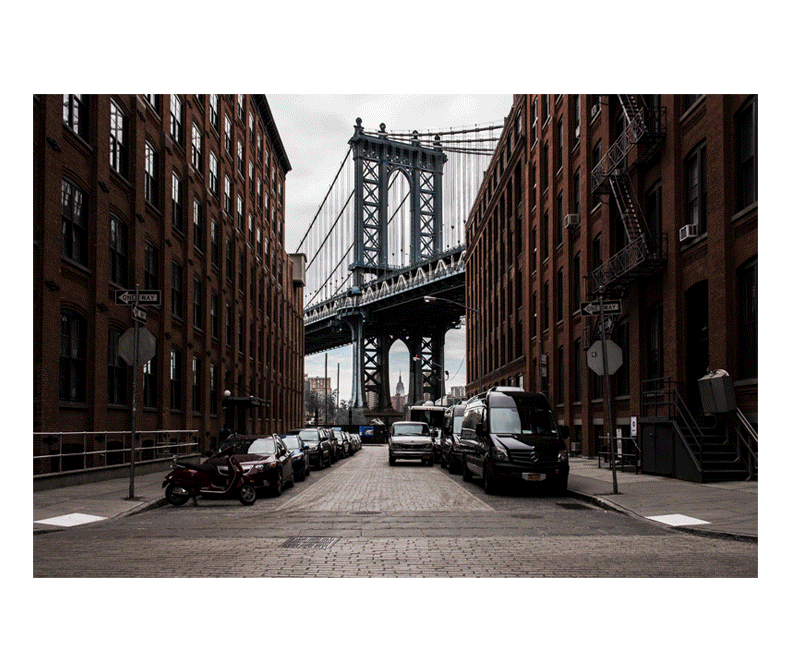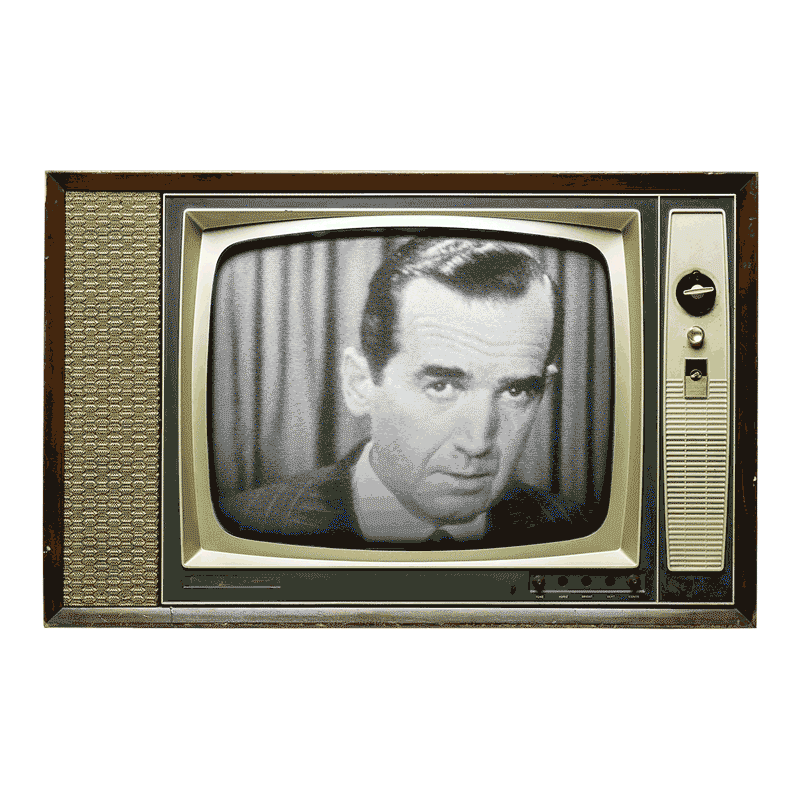This is one of those places you go for Instagram. The Manhattan Bridge looms, immediate and substantial, over a cobblestone street, framed on either side by a pair of old brick buildings; if you’re standing in the right spot, you can see the Empire State Building through one of the bridge’s uprights. Imagine a woman, young and ambivalent, staring into the middle distance, white sneakers aglow in the dawn, bridge overhead. This area of Brooklyn, once home to abandoned factories and warehouses, now hosts an annual festival for $3,000 German cameras.
A couple weeks ago in New Mexico, a few thousand people in suburban Albuquerque were waiting for the president, the one show we’re always watching.
The time between when you enter a Trump rally and when he finally concludes can be long. You might come in from a bright desert evening, as the crowd did that night, and exit into a pitch-black thunderstorm. In between, you wait for Trump, indoors, without windows, listening to the same 20 songs selected by Trump, from Tina Turner to Andrew Lloyd Webber — that are, like anything else selected by Trump, booming into your brain.
Eventually, to kill time, people at the Santa Ana Star Center did the wave. Seven thousand people rose and fell in red hats and T-shirts — to Luciano Pavarotti’s performance of “Nessun dorma” from a Puccini opera. People raised “Latinos for Trump” signs. A group of teens let out long Woooooooos. Pavarotti wailed in Italian. The wave continued right into the playlist’s next track, “Hey Jude.”
“Is there any place more fun and exciting,” the president asked later that night, “than a Trump rally?”
Trump inspires weird scenes like this from the lovers and haters alike. Pull up YouTube now and you can watch him perform a poem in different cities and in different years, sometimes in reading glasses and sometimes without, sometimes dedicated with cruelty and spite to Syrian refugees and sometimes to the US–Mexico border. Despite the provenance of “The Snake” (an R&B song from 1968), the lyrics have that Classic Tragedy vibe that matches Trump’s acid edge id. “‘Oh, shut up, silly woman,’ said the reptile with a grin,” goes the poem. “You knew damn well I was a snake before you let me in.”
He’s the man for a moment of algorithmic timelines.
But the algorithm didn’t used to rule all. Most of the basic experiences on our phones didn’t even exist 10 years ago. In 2010, Instagram launched and the messaging app WhatsApp came to both Android and iOS; in 2011, Snapchat opened for business and Spotify came to the US; in 2013, the workplace chat system Slack launched. When Pew first began collecting data on the subject in 2011, 35% of US adults owned smartphones; in 2019, 81% do. Here at the decade’s end, there are 1 billion global Instagram users.
The early part of the decade was about building the systems. And though Twitter preceded this decade, the platform came to political and cultural prominence in the 2010s. Initially, information flowed in chronological order, unfiltered, strictly concise, and mostly from strangers, which distinguished the platform from the more insular and curated Facebook. During the 2012 election, Barack Obama’s presidential campaign formalized a kind of faux-intimate voice — personal messages, initialed by the candidate — that retained a corporate distance. But that kind of fakery couldn’t hold; as the decade progressed and platforms like Twitter shifted from novel experiences into assumed foundations for business, media, and culture, the nature of what we put into the platforms also changed.
This isn’t contained to Twitter: The internet has finally and firmly moved from being an obscure gathering for nerds to the foundation for most communication. Linguist Gretchen McCulloch traces that history in Because Internet, her recent book that is particularly interested in the different waves of users — people who started using email at work in the ’90s, for instance, or millennials who grew up chatting on instant messaging apps — and how those platforms or users have affected language. These generational differences can manifest in small but familiar ways; McCulloch explores why people who are long accustomed to chat and text use line breaks for timing and emphasis, and intuit information left unsaid in an ellipsis. (Hey are you around…) She contends that a younger generation of users over the last decade, who’ve never known an internet without Facebook or YouTube, have turned to a phone experience that emphasizes control over context: disappearing messages, live video, using second and third accounts for specialization and privacy.
As the 2010s went on, the platforms adopted the live and the disappearing and attempted to reach you with what you care about most — to make the experience less disorienting by focusing on what garners the most attention. During the 2016 election, Instagram added the ephemeral stories and shifted to an algorithmic timeline. “If your favorite musician shares a video from last night’s concert, it will be waiting for you when you wake up, no matter how many accounts you follow or what time zone you live in,” reads the corporate unveiling, a cheerful promise of permanent detachment from the clock in favor of what you (are thought to) care about.
Twitter had built its business on the ordered timeline, but it too introduced algorithmic weighting that same spring. “Someday soon, the tweets you see will be a little more interesting, and the tweets you miss won't be as important,” a former Twitter employee wrote at the time. “And guess what: You won't even notice. You won't! You think you will, but you won't.”
The new Twitter feed transformed how a user perceived something going viral; while a viral tweet used to get a few thousand retweets, it would now get tens of thousands — or even hundreds of thousands — of retweets. Powered by the new algorithmic weighting, the platform’s new quote-tweet function further turned Twitter into an ever-escalating, ever-nesting series of warring comments, dunks, and owns. Memes take hold, then disappear. One link of breaking news might hang suspended in your feed, hurtling through time like when astronauts do zero-gravity somersaults. You might see this as it happens — or 6, 9, 15, 22 hours later.
Trump’s racism, excess, nihilism, humor, and all the rest make him the ideal host for such a system — destroying forever that antiseptic corporate voice. But what Trump does best is reveal the nature of people and institutions. Even when Trump is gone, we’ll still have the algorithms; whether it’s that track from 2009 crossing from TikTok to Spotify, or a politician going live on Instagram, or whatever is happening on your phone right now — we’ve already adapted, and the next thing will be built on that shifting foundation.
Change like this can be overwhelming. The first run of Black Mirror, the dystopian British show that rose and fell inside Netflix, featured an episode about the relentless fragments that people now accumulate. Filmed in 2011, “The Entire History of You” takes an existing technology (the archival breadth of our phones), applies the logical conclusion (in the episode, people receive implants to track their every interaction for later playback), and sets both against a simple Greek tragedy–style story (a husband suspects his wife has betrayed him, and is driven mad by jealousy). The wife, hair over her eyes like a veil, reaches up to replay her memories for her husband.
Even in 2011, the episode presaged the now ever-present dialogue about cutting back, dropping out, and disconnecting: At a dinner, the table marvels at a woman who, without regret, has risked her memory and her eyesight to remove her implant.
The dynamic of overload and disorientation, and the final cathartic break from them, isn’t isolated to Black Mirror — it’s a dominant theme of the last five years of culture.
In real life, in the wake of the election, Facebook, Twitter, Google, and Instagram have talked about screentime limits, mute functions, preventing harassment and abuse — clawing back control. How to Do Nothing, Jenny Odell’s case for reasserting yourself in the tangible world, has become the centerpiece for essays and takes about cutting back and seeing, again, reality free from the algorithmic commodification of the personal. There are the essays about quitting Twitter, or the inherent avarice of Instagram, or reclaiming the life beyond the external presentation of self.
But people always seem to come back.
“This watch tells time,” begins a recent ad for the Apple Watch that then lists off all the other non-time-telling functions the item can do, from taking phone calls to playing music to performing an eletrocardiogram, before looping back around one last time at the end to say “This watch tells time.”
The introduction of this watch (that tells time) in 2015 deepened a kind of existential dilemma for the other kind of watches, which merely tell time. What purpose does a machine serve when the commodity that machine produced is all around us? “Why Men Are Wearing Watches That Don’t Tell Time,” read a Wall Street Journal headline a few years ago, like a riddle, above an old black-and-white photo of Andy Warhol wearing a Swatch.
Some men, the Journal reported, buy vintage mechanical watches but never get them serviced or repaired, or even wind them — they simply leave the watches dead. Stories like this can’t apply to that many people, but even if it’s just one man, somewhere right now, he walks this earth with a beautiful, broken watch.
Over the last decade, there have been little niche resurgences for items like this: record players, for instance, which promise tangible craftsmanship, and an audio experience that can’t be replicated in the digital. For $41.98, you can buy a lime green vinyl copy of Lana Del Rey’s new album and listen to her describe the end of the world and promise that she’s signing off before whispering at the very last moment “I hope the livestream’s almost on…” in perfect offline clarity. It’s hard to shake, however, the idea that these machines are simply counting off something that no longer needs counting, and trying to reassert the physicality of something no longer physical, detached and distinct from where all things meet.
We all know what’s changed — what’s really happened in the 2010s. It’s beneath that bridge in Brooklyn and it’s at the Trump rally in New Mexico, where exiting fans stopped to take selfies with the president speaking behind them in the distance. The man with the broken watch knows, the people who can’t quit know, and so does Lana Del Rey: The internet is no longer a place you go. Who we are on the phone and in the walking world have merged.
This is why algorithmic time is so disorienting and why it bends your mind. Everything good, bad, and complicated flows through our phones, and for those not living some hippie Walden trip, we operate inside a technological experience that moves forward and back, and pulls you with it. Using a phone is tied up with the relentless, perpendicular feeling of living through the Trump presidency: the algorithms that are never quite with you in the moment, the imperishable supply of new Instagram stories, the scrolling through what you said six hours ago, the four new texts, the absence of texts, that text from three days ago that has warmed up your entire life, the four versions of the same news alert. You can find yourself wondering why you’re seeing this now — or knowing too well why it is so. You can feel amazing and awful — exult in and be repelled by life — in the space of seconds. The thing you must say, the thing you’ve been waiting for — it’s always there, pulling you back under again and again and again. Who can remember anything anymore? ●




